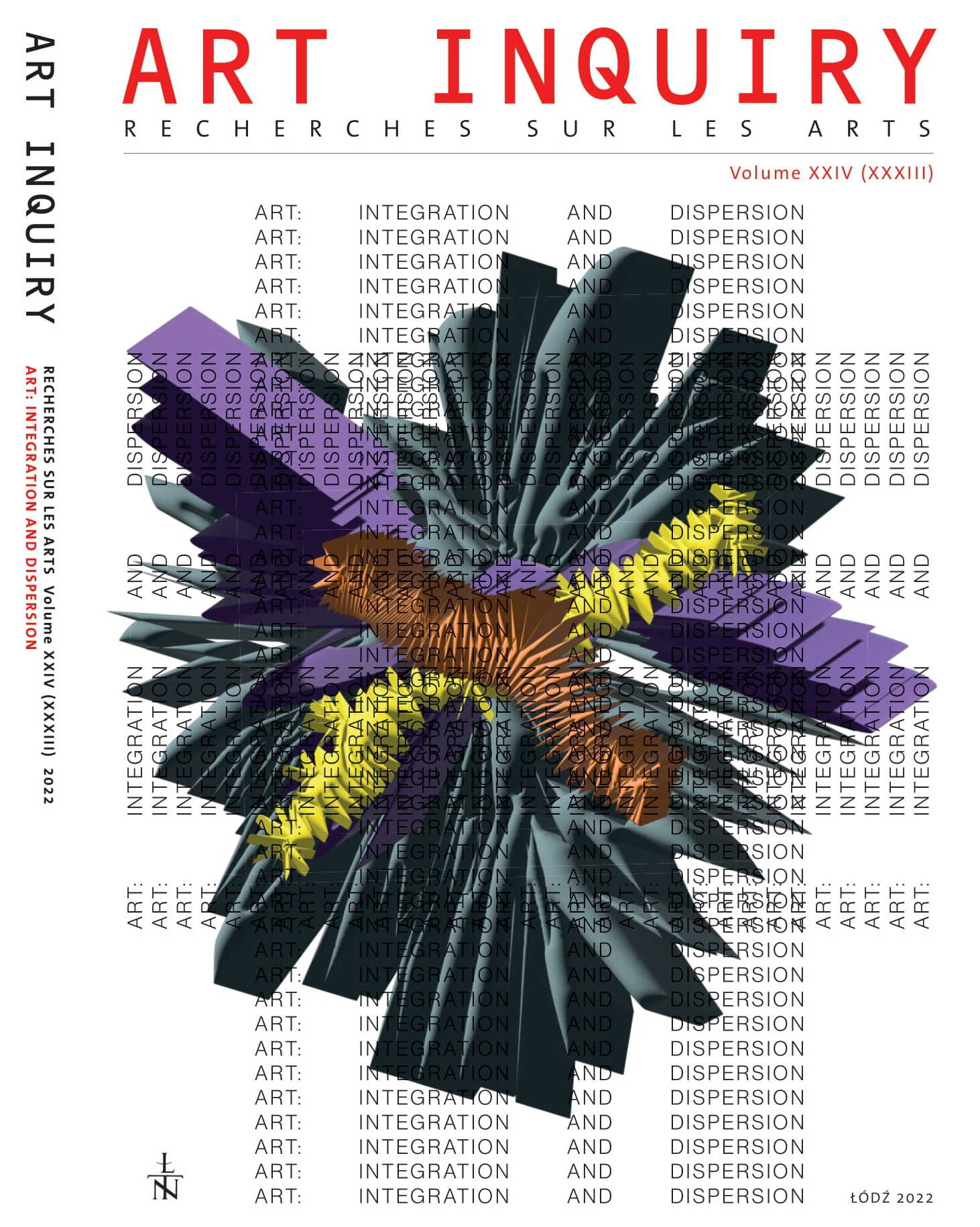Dispersion of a Work of Art – Adam Marczyński, Tadeusz Kantor, Karol Broniatowski
DOI:
https://doi.org/10.26485/AI/2022/24/8Keywords:
dispersion in art, entropy, material turn, the Actor-Network Theory, Alfred Gell's Art and Agency, Adam Marczyński, Tadeusz Kantor, Karol Broniatowski, Polish art of the 20th century.Abstract
The article is an analysis of selected works of art of Polish artists of the 1970s: compositions by Adam Marczyński from the Variable series (the second half of the 1960s and 1970s), the Multipart action by Tadeusz Kantor (1970) and figures by Karol Broniatowski (from the Threat and Big Man series, 1976-1977), in which the title dispersion is understood as a consequence of the disintegration of the prototype by initiating a further journey of its already emancipated components. The material turn perspective was also referred to in the analysis: Bruno Latour's non-anthropocentric Actor-Network Theory (ANT), according to which it can be assumed that a work of art and its creator constitute a certain social network within which all “actors” function on equal terms in the community of “humans and non-humans”, as well as the anthropological theory of art by Alfred Gell, who proposed replacing the study of the object of art as a carrier of symbolic meanings with the study of a work of art as an object in a network of relations, trying to answer questions about the motives and contexts of action of social “makers” (artists) and their production of “indexes” (works of art). In the study, the act of the initial ordering of the system in a work of art and its subsequent disintegration – dispersion – is assessed from the perspective of the concept of entropy, derived from the field of physics, which is a measure of the degree of disorder in a given system – and its opposite, negentropy
References
Arnheim Rudolf (1971) Entropy and Art. An Essay on Disorder and Order, Berkeley–Los Angeles–London: University of California Press.
“Art Inquiry. Recherches sur les arts” (2018) vol. 20 (29). Participation in Art.
Birkhoff George D. (1933) Aesthetic measure, Cambridge: Harvard University Press.
Bishop Claire (2012) Artificial Hells. Participatory Art and the Politics of Spectatorship, London–New York: Verso.
Błotnicka-Mazur Elżbieta (2018) Rethinking Polish Assemblages of the 1960s: the (Re)turn to Things, “Roczniki Humanistyczne”, vol. 66, issue 4, pp. 131-150.
Brown Bill, ed. (2004) Things, Chicago: University of Chicago Press.
Domańska Ewa (2008) Humanistyka nie-antropocentryczna a studia nad rzeczami, “Kultura Współczesna”, no. 3, pp. 9-21.
Domańska Ewa (2005) O zwrocie ku rzeczom we współczesnej humanistyce (Ku historii nieantropocentrycznej), “Roczniki Dziejów Społecznych i Gospodarczych”, vol. 65, pp. 7-23.
Donkers Laura (2020) Deploying collaborative artistic co-creative methods to strategically promote eco-social regeneration for small island communities, vol. 2, submitted to the University of Dun¬dee for the degree of Doctor of Philosophy, https://discovery.dundee.ac.uk/en/studentTheses/deploying-collaborative-artistic-co-creative-methods-to-strategic, accessed: 11 May 2022.
Drake Gordon F.W., Entropy (physics), [in:] Britannica [online], https://www.britannica.com/science/entropy-physics, accessed: 3 February 2022.
Dziamski Grzegorz (2012) Dokumentowanie sztuki jako nowa praktyka artystyczna, “Sztuka i Dokumentacja”, no. 6, pp. 21-27.
Fazan Katarzyna, Burzyńska Anna, Bryś Marta, eds (2014) Tadeusz Kantor Today. Metamorpho¬ses of Death, Memory and Presence, Frankfurt am Main: Peter Lang Edition.
Flam Jack, ed. (1996) Robert Smithson: the collected writings, Berkeley–Los Angeles–London: University of California Press.
Gell Alfred (1998) Art and Agency. An Anthropological Theory, Oxford: Clarendon Oxford.
Gosden Chris, Marshall Yvonne (1999) The cultural biography of objects, “World Archaeology”, vol. 31, no. 2, pp. 169-178.
Howorus-Czajka Magdalena (2016) Adam Marczyński – artysta “poszerzający pole”, “Quart. Kwartalnik Instytutu Historii Sztuki Uniwersytetu Wrocławskiego”, no. 4 (42), pp. 10-25.
Howorus-Czajka Magdalena (2019) Tropami wielokrotności. Strategie powtórzenia w sztuce pol¬skiej lat 60. i 70. XX wieku, Gdańsk: Wydawnictwo Uniwersytetu Gdańskiego.
Kauffman Stuart (1995) At Home in the Universe. The Search for the Laws of Self-Organization and Complexity, Oxford: Oxford University Press.
Kawalec Anna (2016) Sztuka sprawstwa. Antropologiczny wymiar działania/oddziaływania artystycznego, “Przegląd Filozoficzny. Nowa Seria”, vol. 25, no. 2 (98), pp. 103-114.
Kobialka Michal (2009) Further on, Nothing. Tadeusz Kantor’s Theatre, Minneapolis–London: University of Minnesota Press.
Kopytoff Igor (1986) The cultural biography of things, [in:] The social life of things. Commodities in cultural perspective, Arjun Appadurai, ed., Cambridge: Cambridge University Press, pp. 64-91.
Kowalska Bożena (1985) Adam Marczyński 1908-1985, “Projekt”, no. 3, pp. 2-10.
Kowalska Bożena (1985) [sine titulo in:] Adam Marczyński 1908-1985, [ex. cat.], March – April 1985 Kraków, September – October 1985 Łódź, Kraków: BWA Kraków.
Krajewski Marek (2012) Style życia przedmiotów. Zarys koncepcji, [in:] Style życia, wartości, oby-czaje. Stare tematy, nowe spojrzenia, Aldona Jawłowska, Wojciech Pawlik, Barbara Fatyga, eds, Warszawa: Wydawnictwa Uniwersytetu Warszawskiego, pp. 49-70.
Latour Bruno (2005) Reassembling the Social. An Introduction to Actor-Network-Theory, Oxford: Oxford University Press.
Łarionow Dominika (2018) Tadeusz Kantor – Engagement – Multiplication – Participation, “Art Inquiry. Recherches sur les arts”, vol. 20 (29), pp. 235-244.
Mikina Ewa (1979) [sine titulo in:] Karol Broniatowski. Prace z lat 1970-79, [ex. cat.], Muzeum Sztuki w Łodzi, 30 October – 2 December 1979, Łódź: Muzeum Sztuki, pp. 6-8.
Kantor Tadeusz (2000) Metamorfozy. Teksty o latach 1938-1974, elab. Krzysztof Pleśniarowicz, Kraków: Księgarnia Akademicka.
Roberts Jennifer L. (2017) Things: Material Turn, Transnational Turn, “American Art”, vol. 31, no. 2, pp. 64-69.
Skrodzki Wojciech (1977) Dzieła i poszukiwania, [in:] Andrzej Osęka, Wojciech Skrodzki, Współ-czesna rzeźba polska, Warszawa: Arkady, pp. 19-45.
Smithson Robert (1966) Entropy and the new Monuments, “Art Forum ”, vol. 4, no. 10 (June), pp. 26-31.
Schrödinger Erwin (1944) What is life?, Cambridge: Cambridge University Press.
Szmelter Iwona (2017) Elementy nowej teorii konserwacji dziedzictwa sztuki wizualnej. Ratunek dla ochrony dawnej sztuki nietypowej i sztuki współczesnej, “Sztuka i Dokumentacja”, no. 17, pp. 155-181.
Szmelter Iwona (2017) Fenomeny społecznej roli sztuki a demokratyzacja. Od zarania kultury do sztuki Kantora i Abakanowicz. Percepcja, ochrona i zachowanie, “Sztuka i Dokumentacja”, no. 16, pp. 49-61.
Tsing Anna (2012) Unruly Edges: Mushrooms as Companion Species. For Donna Haraway, “Environmental Humanities”, vol. 1, pp. 141-154.
Wamberg Jacob (2020) Jak sztuka stała się posthumanistyczna. Rozszerzenie koncepcji historiogra-fii, “Szum”, 10.07.2020, https://magazynszum.pl/jak-sztuka-stala-sie-posthumanistyczna-rozsze-rzenie-koncepcji-historiografii/, accessed: May 7, 2022



